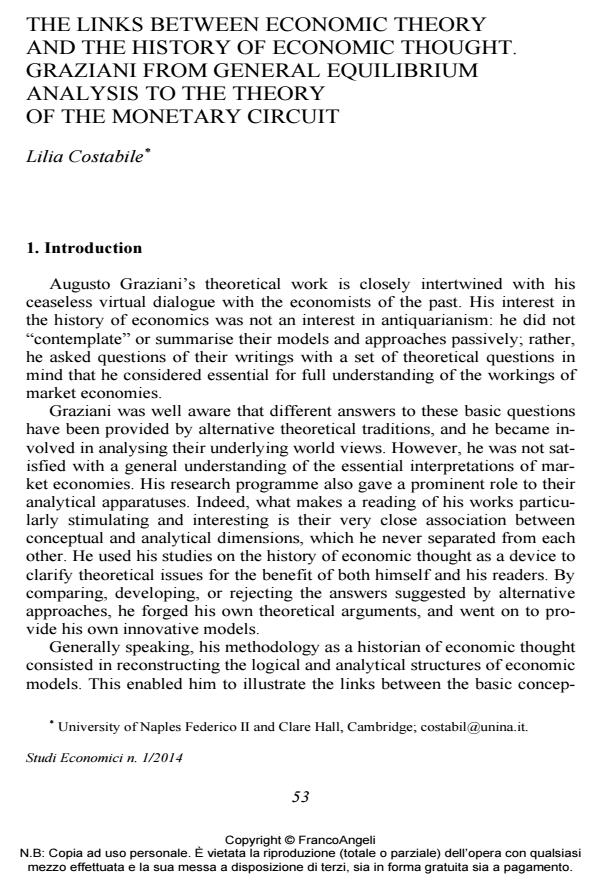The links between economic theory and the history of economic thought. Graziani from general equilibrium analysis to the theory of the monetary circuit
Journal title STUDI ECONOMICI
Author/s Lilia Costabile
Publishing Year 2015 Issue 2014/112
Language English Pages 19 P. 53-71 File size 72 KB
DOI 10.3280/STE2014-112004
DOI is like a bar code for intellectual property: to have more infomation
click here
Below, you can see the article first page
If you want to buy this article in PDF format, you can do it, following the instructions to buy download credits

FrancoAngeli is member of Publishers International Linking Association, Inc (PILA), a not-for-profit association which run the CrossRef service enabling links to and from online scholarly content.
Augusto Graziani’s theoretical work is closely intertwined with his ceaseless virtual dialogue with the economists of the past. Here I propose a novel investigation of the links that connect his theoretical work with his studies in the history of economic thought. I consider how the evolution of Graziani’s own theoretical approach went hand in hand with his studies on other economists and schools of thought, from his early analysis of General Equilibrium Theory to the Theory of the Monetary Circuit. Walras, Pareto, Barone, Knight, Hayek, Hicks, Fuà, Malthus, Marx, Wicksell, Schumpeter, Robertson, Fanno, Keynes are some, but by no means all, of the authors to whom Graziani devoted his attention. I illustrate the relationships between their models and Graziani’s own theoretical framework. This investigation sheds light on Graziani’s critical approach to the history of the discipline, and on the very close association between the analytical and the conceptual dimensions of his work.
Keywords: Graziani, History of Economic Thought, General Equilibrium Theory, Theory of the Monetary Circuit.
Jel codes: B31, B 59, D51, E40, E51
- The modern Italian debate on the Walrasian theory of capitalization (1960-1971) Giovanni Michelagnoli, in HISTORY OF ECONOMIC THOUGHT AND POLICY 1/2021 pp.131
DOI: 10.3280/SPE2021-001006 - Una Nota Sui Contributi Di Augusto Graziani E Di Paolo Sylos Labini Al Dibattito Sulla Natura DelllOfferta Di Moneta (A Note About Contributions by Augusto Graziani and Paolo Sylos Labini at the Debate on the Nature of the Money Offer) Stefano Figuera, in SSRN Electronic Journal /2016
DOI: 10.2139/ssrn.3140382 - Graziani and Napoleoni on the Nature and the Dynamics of Capitalism Lilia Costabile, in International Journal of Political Economy /2025 pp.310
DOI: 10.1080/08911916.2025.2534747
Lilia Costabile, The links between economic theory and the history of economic thought. Graziani from general equilibrium analysis to the theory of the monetary circuit in "STUDI ECONOMICI " 112/2014, pp 53-71, DOI: 10.3280/STE2014-112004